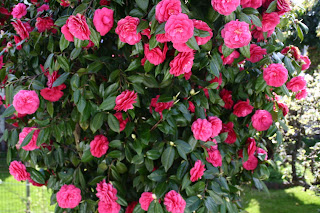My wife and I (less so) are not immune to the siren call of spring. As I write this, my wife has made plans for me to remove a section of fence (it's just a small piece of plastic lattice in our rose patch in the back of the house) and to put some soil from old flower pots onto the front flower bed. Down the line, I'll be expected to power-wash the back porch and the concrete sections of our back yard. Yes, the rites and rituals of spring require their fulfillment - and I know on which side my bread is buttered.

What we won't do is use commercial grass fertilizers, chemical weed removers, or pesticides on our grass - we also don't water it during summer. The grass is interspersed with moss as well (see picture). Our "lawn" is "un-manicured" and will turn brown here and there when the days get hot, but it always has recovered. I consider drying out a natural event, and the grass seems to be more resilient and resistant to pests because of that. We don't seem to get the "chiggers" that periodically infest our neighbourhood and which crows dig out from underground - and as result, our grass doesn't have the "plowed-up" look.


 Of course, gardening efforts have as one of their rewards nice looking flowers. Above is a continuation of the evolution of one of the buds on our neighbours' camelia bush. Notice how the branch in front of the flower has grown steadily since the series was started on March 22. The flower is located in the centre of the picture at left, showing more of the camelia bush.
Of course, gardening efforts have as one of their rewards nice looking flowers. Above is a continuation of the evolution of one of the buds on our neighbours' camelia bush. Notice how the branch in front of the flower has grown steadily since the series was started on March 22. The flower is located in the centre of the picture at left, showing more of the camelia bush.You don't get something for nothing.
1 comment:
Lovely to see the unfolding of the flower.
Post a Comment